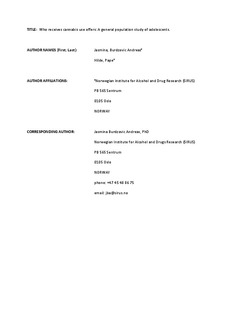| dc.description.abstract | Drug use is predicated on a combination of “willingness” and “opportunity”. That is, independent of any desire to use drugs, a drug use opportunity is required; be it indirect (i.e., being in a drug-use setting) or direct (i.e., receiving a direct drug offer). However, whether some youth are more likely to encounter such direct drug use opportunities is not fully known. We examined whether certain characteristics placed adolescents at greater risk for being offered cannabis, after accounting for a number of demographic-, contextual-, interpersonal-, and personal-level risk factors. We utilized data from a Norwegian school survey (n = 19,309) where the likelihood of receiving cannabis offer in the past year was estimated using logistic regression models. Substantive focus was on the individual and combined effects of personal (i.e., delinquency) and interpersonal (i.e., cannabis-using close friend) risk factors. Separate models were fit for middle- and high-school students. Delinquency was a significant risk factor for receiving cannabis offers, as was a cannabis-using best friend. In addition, peer cannabis use increased the risk of cannabis offers mostly for adolescents on the lower delinquency spectrum, but less so for highly delinquent adolescents. These interaction effects were primarily driven by the middle-school cohort. Cannabis offers were more likely to be extended to youth of certain high-risk profiles. Targeted prevention strategies can therefore be extended to a general profile of younger adolescents with externalizing problems and cannabis-using peers. | |
